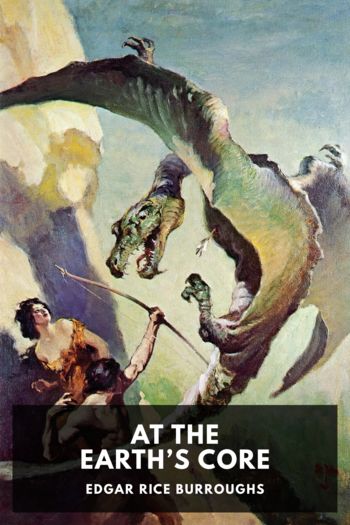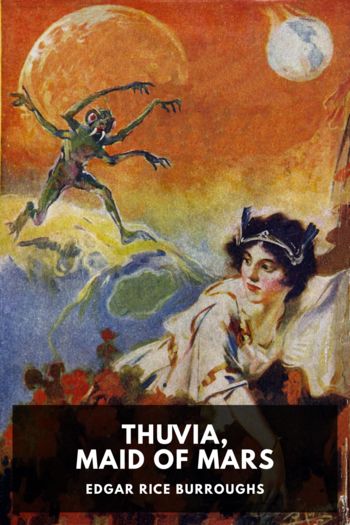At the Earth’s Core by Edgar Rice Burroughs (ebook reader with internet browser TXT) 📕

Description
At the Earth’s Core, published in 1914, is the first of a series of science fiction novels written by Edgar Rice Burroughs set inside a hollow earth with a central “sun,” a land called Pellucidar. However unlikely this scenario, it allowed Burroughs free play to create heroic adventures in yet another alien environment in addition to his fantastic version of Mars in his Martian series.
The story’s hero, David Innes, is recruited by an old man, Perry, to help fund his invention, a “mechanical subterranean prospector,” and then to test it out. Unfortunately once the powerful burrowing machine is set going, it cannot be steered, and the pair find themselves burrowing deeper and deeper into the Earth’s crust. To their astonishment, rather than dying from suffocation or increasing heat, they emerge inside a hollow shell inside the Earth. This world is populated by prehistoric creatures as well as primitive humans, intelligent gorillas, and supremely intelligent pterosaurs, the masters of this land. David and Perry are captured by these creatures and many adventures ensue.
Read free book «At the Earth’s Core by Edgar Rice Burroughs (ebook reader with internet browser TXT) 📕» - read online or download for free at americanlibrarybooks.com
- Author: Edgar Rice Burroughs
Read book online «At the Earth’s Core by Edgar Rice Burroughs (ebook reader with internet browser TXT) 📕». Author - Edgar Rice Burroughs
“I did not know, Ghak,” I cried. “I did not know. Not for all Pellucidar would I have harmed Dian the Beautiful by word, or look, or act of mine. I do not want her as my slave. I do not want her as my—” but here I stopped. The vision of that sweet and innocent face floated before me amidst the soft mists of imagination, and where I had on the second believed that I clung only to the memory of a gentle friendship I had lost, yet now it seemed that it would have been disloyalty to her to have said that I did not want Dian the Beautiful as my mate. I had not thought of her except as a welcome friend in a strange, cruel world. Even now I did not think that I loved her.
I believe Ghak must have read the truth more in my expression than in my words, for presently he laid his hand upon my shoulder.
“Man of another world,” he said, “I believe you. Lips may lie, but when the heart speaks through the eyes it tells only the truth. Your heart has spoken to me. I know now that you meant no affront to Dian the Beautiful. She is not of my tribe; but her mother is my sister. She does not know it—her mother was stolen by Dian’s father who came with many others of the tribe of Amoz to battle with us for our women—the most beautiful women of Pellucidar. Then was her father king of Amoz, and her mother was daughter of the king of Sari—to whose power I, his son, have succeeded. Dian is the daughter of kings, though her father is no longer king since the sadok tossed him and Jubal the Ugly One wrested his kingship from him. Because of her lineage the wrong you did her was greatly magnified in the eyes of all who saw it. She will never forgive you.”
I asked Ghak if there was not some way in which I could release the girl from the bondage and ignominy I had unwittingly placed upon her.
“If ever you find her, yes,” he answered. “Merely to raise her hand above her head and drop it in the presence of others is sufficient to release her; but how may you ever find her, you who are doomed to a life of slavery yourself in the buried city of Phutra?”
“Is there no escape?” I asked.
“Hooja the Sly One escaped and took the others with him,” replied Ghak. “But there are no more dark places on the way to Phutra, and once there it is not so easy—the Mahars are very wise. Even if one escaped from Phutra there are the thipdars—they would find you, and then—” the Hairy One shuddered. “No, you will never escape the Mahars.”
It was a cheerful prospect. I asked Perry what he thought about it; but he only shrugged his shoulders and continued a longwinded prayer he had been at for some time. He was wont to say that the only redeeming feature of our captivity was the ample time it gave him for the improvisation of prayers—it was becoming an obsession with him. The Sagoths had begun to take notice of his habit of declaiming throughout entire marches. One of them asked him what he was saying—to whom he was talking. The question gave me an idea, so I answered quickly before Perry could say anything.
“Do not interrupt him,” I said. “He is a very holy man in the world from which we come. He is speaking to spirits which you cannot see—do not interrupt him or they will spring out of the air upon you and rend you limb from limb—like that,” and I jumped toward the great brute with a loud “Boo!” that sent him stumbling backward.
I took a long chance, I realized, but if we could make any capital out of Perry’s harmless mania I wanted to make it while the making was prime. It worked splendidly. The Sagoths treated us both with marked respect during the balance of the journey, and then passed the word along to their masters, the Mahars.
Two marches after this episode we came to the city of Phutra. The entrance to it was marked by two lofty towers of granite, which guarded a flight of steps leading to the buried city. Sagoths were on guard here as well as at a hundred or more other towers scattered about over a large plain.
V SlavesAs we descended the broad staircase which led to the main avenue of Phutra I caught my first sight of the dominant race of the inner world. Involuntarily I shrank back as one of the creatures approached to inspect us. A more hideous thing it would be impossible to imagine. The all-powerful Mahars of Pellucidar are great reptiles, some six or eight feet in length, with long narrow heads and great round eyes. Their beak-like mouths are lined with sharp, white fangs, and the backs of their huge, lizard bodies are serrated into bony ridges from their necks to the end of their long tails. Their feet are equipped with three webbed toes, while from the fore feet membranous wings, which are attached to their bodies just in front of the hind legs, protrude at an angle of 45 degrees toward the rear, ending in sharp points several feet above their bodies.
I glanced at Perry as the thing passed me to inspect him. The old man was gazing at the horrid creature with wide astonished eyes. When it passed on, he turned to me.
“A rhamphorhynchus of the Middle Olitic, David,” he said, “but, gad, how enormous! The largest remains we ever have discovered have never indicated a size greater than that attained by an ordinary crow.”
As we continued on through the main avenue





Comments (0)